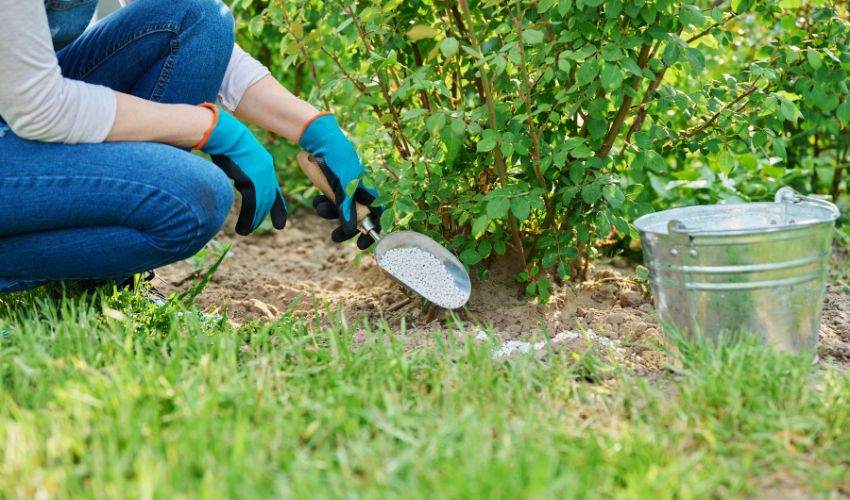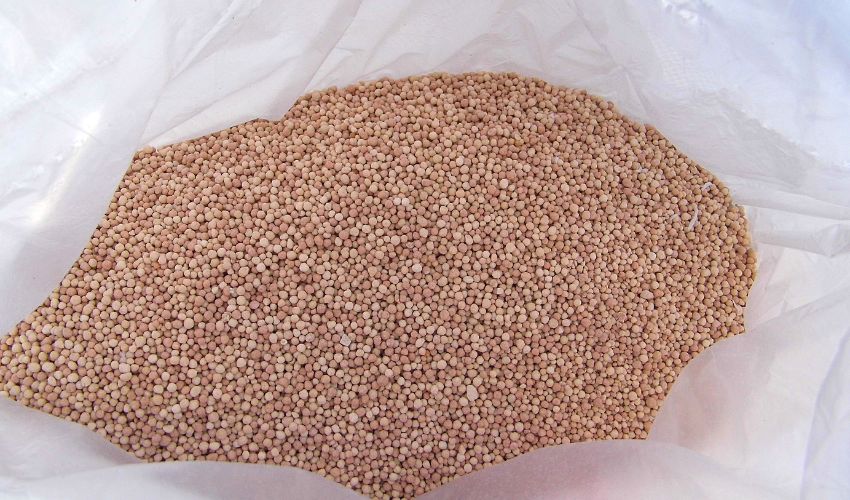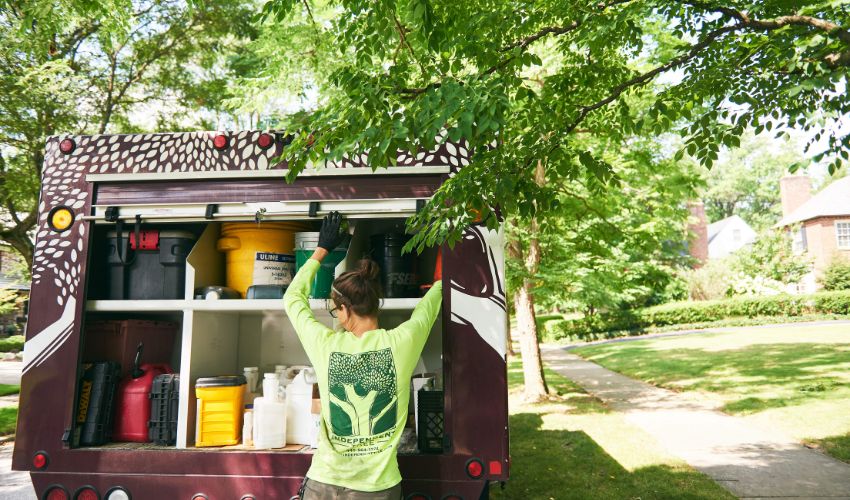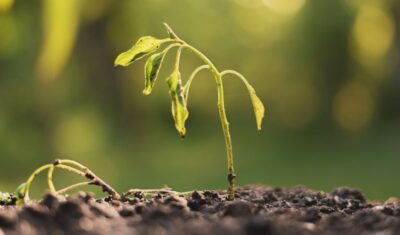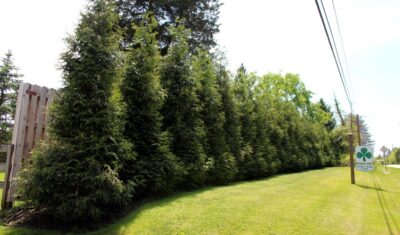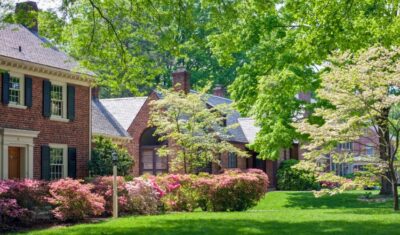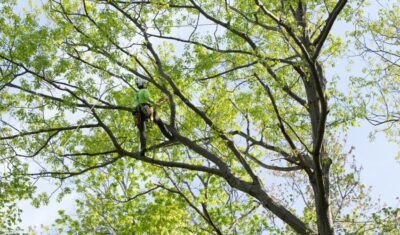Are you tired of spending endless hours fertilizing your trees and worrying about whether they’re getting the nutrients they need? Do your trees have fewer flowers than you remember, yellowing leaves, or a thinner canopy? Look no further than slow-release tree fertilizers! In northeast Ohio, these fertilizers offer numerous advantages that will save you time and effort, while also promoting the health and growth of your trees.
If you want long-lasting, healthy, and safe trees in your Northeast Ohio yard, you need to be feeding them the nutrients they need on a regular basis. The best way to provide your trees with the exact nutrients they need, when they need it, is by applying a long-lasting, slow-release fertilizer to the soil beneath your trees.
Keep reading to discover the benefits of slow-release fertilizer, how it works, which types to use, and to find out if you should be applying this in your yard.
Why should you fertilize your trees?
Much like the nutrients our bodies need to stay healthy, trees need specific nutrients to develop a strong branch structure, put out leaves, produce flowers, and set fruit, all while also fighting off pests and diseases.
In a natural environment, leaves, sticks, and other organic materials would normally collect and break down over time, replenishing the soil with nutrients that are used by trees and plants.
But in most yards and public places, organic matter like fallen leaves is cleaned up long before they can break down and feed the soil. So, in residential yards, the periodic use of fertilizers becomes extremely important.
What is slow-release fertilizer?
Slow-release fertilizers are solid fertilizers, typically in granular or pellet form. Rather than feeding trees nutrients immediately, they break down and release smaller amounts of nutrients over longer periods of time. This ensures a steady supply of nitrogen and other nutrients over longer periods and prevents exposure to excessive amounts of nutrients that can harm the tree.
Slow-release fertilizers have a slower release rate than conventional water-soluble fertilizers, but they do not have a controlled or predictable nutrient release pattern. The release of nutrients depends on factors like microbial activity, moisture, temperature, pH, and organic matter in the soil. They are water-insoluble, so rain or irrigation won’t speed up the nutrient-release process.
How is this different from controlled-release fertilizer?
Controlled-release fertilizers have a well-known and controllable nutrient release pattern and duration. They contain soluble plant nutrients that are encapsulated in a semi-permeable coating or membrane, often made of resins, polymers, waxes, or sulfur. The rate of nutrient release from these types of fertilizer is primarily controlled by the thickness and composition of the coating, as well as temperature.
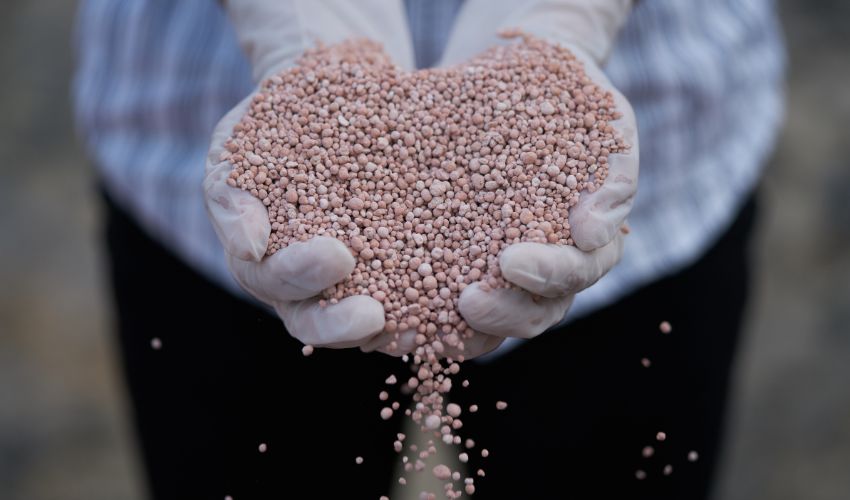
Slow-release fertilizer is typically composed of granules or pellets.
How does it differ from fast-release fertilizer?
Fast-release fertilizers use water-soluble forms of nitrogen, such as potassium nitrate and ammonium nitrate. They often come in liquid form and are applied with a sprayer or hose. They are easily absorbed into the soil without the extra effort of watering them in.
These fertilizers provide an instant boost of nutrients to the root system of plants and trees, allowing them to absorb and use the nutrients immediately.
Fast-release fertilizers promote quick root growth and greener leaves. They are used to provide an immediate “green-up.” However, it’s easy to over-apply these fertilizers, which can burn plants and trees. And they don’t encourage a strong root structure. Using them too frequently can lead to weaker trees.
Are there both organic and synthetic types of slow-release fertilizer?
Slow-release fertilizer can either be made of organic or synthetic materials. Most homeowners use synthetic fertilizers.
Organic slow-release fertilizers are those made from natural materials that decompose slowly over time. This includes manure, bone meal, fish emulsion, kelp, and mulch.
Synthetic slow-release fertilizers can be purchased in bags and applied with a spreader. These granules or pellets are coated with either plastic resin or sulfur-based polymers that slowly break down. These fertilizers can take up to a year before fully releasing the nutrients within.
What are the benefits of using slow-acting fertilizer?
There are many reasons to use a slow-release or controlled-release fertilizer on your trees in Northeast Ohio. Here’s why you should consider this simple, yet effective habit.
Prevent Nutrient Burn
Since nutrients are released in small amounts over time, trees and plants are rarely inundated with excessive nutrients. This happens often when improperly applying fast-release fertilizers. Too much can lead to nutrient burn, which can damage roots and lead to browning on leaves and foliage.
Provide a Steady Stream of Nutrients
Slow-release fertilizers mimic natural decomposition found in nature, where organic matter like leaves would eventually rot and release nutrients into the soil. By releasing smaller amounts of nutrients over time, slow-release fertilizers provide a consistent supply of the nutrients they need, similar to what happens in the natural world.
Reduce Leaching
Fast-release fertilizers are notorious for leaching. Since the nutrients are water-soluble, heavy rain or even irrigation can carry the nutrients deeper into the soil, leaching them away from the root zone of trees and plants. This is costly both to you and to the plants that depend on those nutrients.
Because slow-release fertilizers are coated and are water-insoluble, the leaching of excessive nitrogen into the soil is reduced or prevented. The fertilizer remains near the roots and continues releasing just enough for trees and plants to fully absorb without excess nutrients going to waste.
Save Time and Energy
Slow-release fertilizers provide near-constant fertilization for weeks, if not months at a time, reducing the need for frequent applications. Depending on the size of your yard or the number of trees, plants, or grass you have, fewer applications can save a lot of money, time, and energy.
However, you likely will need to apply slow-release fertilizer multiple times throughout the year. If you’d like to ensure your trees and plants are fed, but don’t want to manage this yourself, you can call us at 440-564-1374 to schedule a consultation. Let the experts at Independent Tree properly care for your trees in Northeast Ohio.
Improve Soil Quality
While quick-release fertilizers feed trees and plants immediately, they do little for the soil itself. Slow-release fertilizers work to improve soil quality over time by encouraging the growth of microorganisms that aid in the decomposition of organic material. This enhances soil structure, leads to better water retention, and increases the availability of nutrients.
Promote a Healthy Root System
Healthier soil leads to healthier roots. Healthy roots lead to healthy, long-lasting, strong trees that are more resistant to damage from pests and diseases. A more robust root system can also decrease the likelihood of a tree falling in severe weather and causing damage to property.
Are there any drawbacks to choosing a controlled- or slow-release fertilizer?
Homeowners use fertilizers to create healthier, more beautiful trees and plants. But slow-release fertilizers won’t provide any immediate boosts in your plants’ appearance.
It can take weeks, if not months to start seeing greener leaves and a lusher canopy. However, just because you can’t see any improvements doesn’t mean there aren’t any. Whether you see it in the leaves or not, slow-release fertilizers are hard at work improving soil quality and a steady stream of nutrients to promote strong root growth and overall vigor.
The other downside is that slow-release fertilizers typically cost more money upfront than fast-release fertilizers. But when you realize that you’ll perform fewer applications over time, you may end up saving money in the long-run by choosing slow-release as opposed to a quick-release fertilizer.
What time of year should you apply these types of fertilizers?
Here in Northeast Ohio, the best time to apply slow-release fertilizer is in the spring, after trees emerge from winter dormancy. By applying fertilizer early in the season, trees will have steady access to the nutrients they need to support new growth in spring and carry them into early summer.
Applying slow-release fertilizer in the fall is also recommended. As the fertilizer slowly dissolves, nutrients feed the trees throughout the winter and supply them with nutrient stores that can be used the following spring.
During spring and fall, roots are actively growing, making this the best time to fertilize trees.
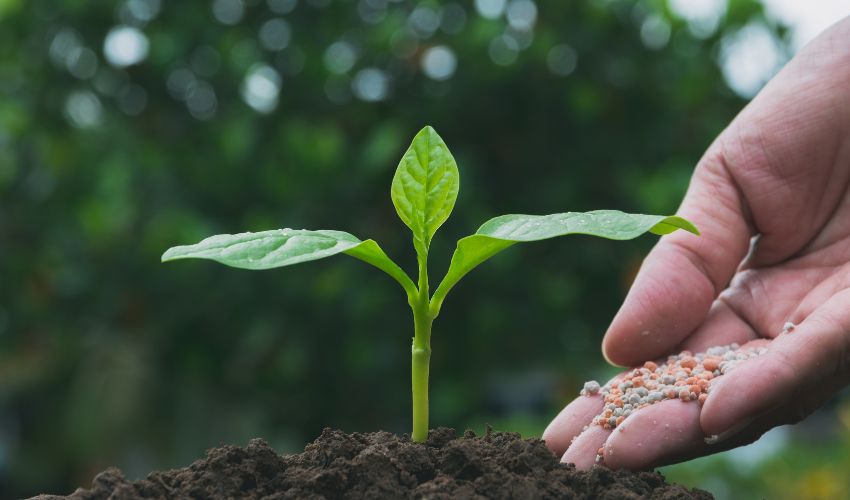
Slow-release fertilizer can be applied by hand to target specific trees or plants.
How much coated fertilizer should you use?
Wondering how to apply slow-release or controlled-release fertilizer and how much to use? Here’s what to consider.
Consider Specific Trees and Plants
There’s no one-size-fits-all when it comes to fertilizer. Different fertilizers contain different nutrient profiles and are intended for different types of plants. You’ll apply a different slow-release fertilizer to your lawn than you would to your trees or to a flower bed.
Consider the specific trees and plants you’re looking to fertilize and choose a fertilizer specifically tailored to that type of plant. For a variety of plants and trees, that may mean applying several types of fertilizers.
Test Your Soil
It helps to know what nutrients are lacking in your soil to ensure you choose a slow-release fertilizer with the right proportion of nitrogen, phosphorus, and potassium (NPK), as well as any micro-nutrients that may be needed.
The Ohio State University recommends numerous laboratories to contact for soil testing.
How to Apply Slow-Release Fertilizers
If you’re applying slow-release fertilizer to specific trees and plants, it’s generally more effective to spread by hand. Wear gloves and sprinkle handfuls of granules into the soil around the base of individual plants. Take care not to get fertilizer on the plant itself, as this could cause damage.
When applying to trees, try to cover the entire root zone. Tree roots extend about twice as far from the trunk of the tree as the branches do. It may help to measure and mark this area with a hose or rope. If this area is filled in with grass, don’t spread granular fertilizer unless the grass is completely dry. Make sure to keep granules 3 or 4 feet away from tree trunks.
If the application area is too large to apply granules by hand, use a handheld or wheeled fertilizer spreader to make short work of the task. Follow the instructions for your specific fertilizer to ensure you apply the proper amount.
Finish by watering the fertilizer into the soil. Doing this helps the granules to sink into the soil where it will stay for 8-10 weeks, rather than getting blown about by the wind or washed away by the rain.
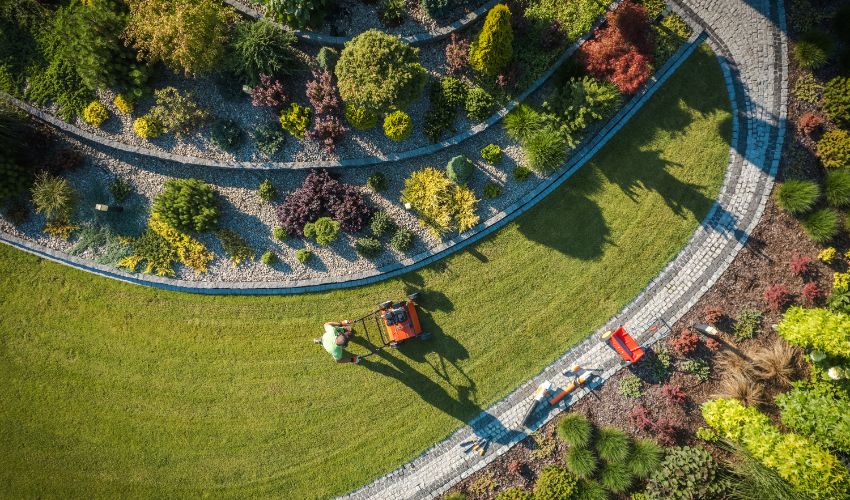
Take care to keep fertilizer in the soil, and off hard surfaces or foliage.
Application Mistakes to Avoid
Don’t apply slow-release fertilizer directly onto plants, trees, trunks, or stems. Only apply granules to the soil around the base of plants or you may damage or burn the foliage.
Don’t spread slow-release fertilizer when plants or grass are wet. Doing so can cause the granules to stick to the plant, causing damage.
Don’t forget to check the label. Instructions are provided to ensure you don’t over-apply the fertilizer.
Don’t forget to clean up when you’re done. If granules of fertilizer end up on concrete or other hardscapes, sweep it up or blow it into the soil using a leaf blower to avoid runoff and possible staining.
FAQs About Slow-Release Fertilization for Trees
Q: Do different types of trees need different types of slow-release fertilizer?
A: Yes, different types of trees will benefit from different types of slow-release fertilizers.
Fertilizers are made up of both macronutrients (nitrogen, phosphorus, and potassium) and micronutrients (such as iron, magnesium, and manganese). Each fertilizer will contain these elements in different proportions and are intended for different types of trees.
For best results here in Northeast Ohio, give us a call at 440-564-1374 for assistance in selecting the right fertilizer for the trees on your property.
Q: Can you over-fertilize with slow-release products?
A: One of the main benefits of slow-release fertilizer is that it is difficult to over-fertilize and damage trees since nutrients are released in such limited quantities. Still, you don’t want to apply more fertilizer than necessary. Trees can only take in a certain amount of nutrients at a time. At best, applying too much fertilizer is wasteful. At worst, it can cause fertilizer burn.
Q: Can you combine slow-release with quick-release fertilizer?
A: Many homeowners combine slow-release fertilizers with quick-release fertilizers to enjoy the benefits of both. Doing so has the potential to provide a quick green-up, encouraging new, brighter foliage to emerge, while also supporting the soil and roots with slowly-released nutrients.
However, for inexperienced homeowners, there is risk of over-fertilizing. If you want your trees to look their best right away, it’s best to work with local tree care professionals who can recommend and apply the appropriate combination of nutrients using the right formulation for your needs.
Q: What about deep root fertilization?
A: Deep root fertilization is a technique used primarily by trained tree care professionals. This method is far more efficient at feeding trees than DIY fertilization applications.
Spreading granular fertilizers on the soil surface and watering them in rarely allows nutrients to penetrate the soil deeply enough to fully support the root zone of a mature tree. This is particularly true for trees surrounded by lawn, where the grass often absorbs the nutrients before they reach the tree roots below.
With deep root fertilization, tree care professionals can inject liquid fertilizer directly into the root zone of trees, ensuring they get the nutrients they need more efficiently. These applications also last much longer than topical applications.
Q: Should you use different fertilizers at different times of the year?
A: The type of fertilizer you apply in the spring may be different from what you use in the fall. In the spring, you’ll want to promote new leaf growth. But in the fall, you don’t want to give your trees nutrients that encourage leaf growth, since they are about to lose their leaves and enter dormancy. It’s best to avoid high nitrogen fertilizers in fall to prevent stimulating new leaf growth.
Let Independent Tree Bring Your Trees Back to Full Health
Are you concerned about the health of your trees here in Northeast Ohio? Have you noticed any signs of disease or damage, and are wondering if the use of slow-release fertilizer could get your trees back on track?
If so, it’s best to have a certified, local Northeast Ohio arborist examine your trees. There may be other issues present that fertilizer alone wouldn’t fix.
Here at Independent Tree, our team of certified arborists and tree health professionals can identify and remediate any problems your trees are facing in the Chagrin Valley and surrounding areas. If your trees need fertilization, we can craft a plan specifically tailored to your trees to ensure optimal tree health.
Call us at 440-564-1374 to schedule a free consultation or use our online form to request an estimate today.
Contact Independent Tree
Independent Tree can evaluate your trees and determine if fertilization is needed and the best type to use for your trees and property.Recent Articles
Topics
About The Author

STAY IN THE LOOP
WITH OUR
LATEST UPDATES
"*" indicates required fields

